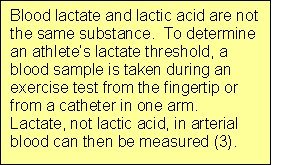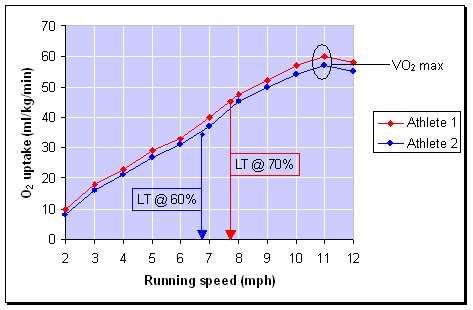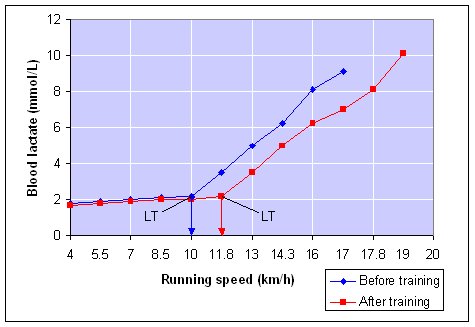If VO2 max is your aerobic endurance potential then your lactate threshold plays a significant role in how much of that potential you are tapping.
Lactate threshold has been defined as:
The point during exercise of increasing intensity at which blood lactate begins to accumulate above resting levels, where lactate clearance is no longer able to keep up with lactate production. (3)
During low intensity exercise, blood lactate remains at or near to resting levels. As exercise intensity increases there comes a break point where blood lactate levels rise sharply (4,5). Researchers in the past have suggested that this signifies a significant shift from predominantly aerobic metabolism to predominantly anaerobic energy production.
Several terms have been used to describe this shift and many coaches and athletes believe it is the same phenomenon:
- Lactate threshold
- Anaerobic threshold
- Aerobic threshold
- Onset of blood lactate accumulation (OBLA)
- Maximal lactate steady state

Although these terms are used interchangeably, they do not describe the same thing. Lactate accumulation only determines the balance between lactate production and its clearance and suggests nothing about the availability or lack of oxygen so the terms aerobic and anaerobic become a bit misleading.
The reasons for lactate accumulation are complex and varied and not yet fully understood. For more information on this topic see the lactic acid article.
OBLA
At a slightly higher exercise intensity than lactate threshold a second increase in lactate accumulation can be seen and is often referred to as the onset of blood lactate accumulation or OBLA. OBLA generally occurs when the concentration of blood lactate reaches about 4mmol/L (6,7). The break point that corresponds to lactate threshold can often be hard to pinpoint and so some Exercise Physiologists often prefer using OBLA.
Maximal Lactate Steady State
Maximal lactate steady state is defined as the exercise intensity at which maximal lactate clearance is equal to maximal lactate production (8). Maximal lactate steady state is considered one of the best indicators of performance perhaps even more efficient than lactate threshold (8,9).
Lactate Threshold as a Percentage of VO 2 Max
The lactate threshold is normally expressed as a percentage of an individuals VO2 max. For example, if VO2 max occurs at 24 km/h on a treadmill test and a sharp rise in blood lactate concentration above resting levels is seen at 12 km/h then the lactate threshold is said to be 50% VO2 max.
In theory, an individual could exercise at any intensity up to their VO2 max indefinitely. However, this is not the case even amongst elite athletes. As the exercise intensity draws closer to that at VO2 max, a sharp increase in blood lactate accumulation and subsequent fatigue occurs the lactate threshold is broken. In world-class athletes lactate threshold typically occurs at 70-80% VO2 max. In untrained individuals it occurs much sooner, at 50-60% VO2 max (10,11).
Generally, in two people with the same VO2 max, the one with a higher lactate threshold will perform better in continuous-type endurance events. See the graph below:

Although both Athlete 1 and Athlete 2 reach VO2 max at a similar running speed, Athlete 1 has a lactate threshold at 70% and Athlete 2 has a lactate threshold at 60%. Theoretically, Athlete 1 can maintain a pace of about 7.5 mph (12 km/h) compared to Athlete 2s pace of about 6.5 mph (10.5km/h).
VO2 max has been used to predict performance in endurance events such as distance running and cycling but the lactate threshold is much more reliable. Race pace has been closely associated with lactate threshold (11).
There are several non-invasive methods used to determine the lactate or anaerobic threshold. For more information see How to Determine Your Anaerobic Threshold.
Lactate Threshold and Training
With training, lactate threshold as a percentage of VO2 max can be increased. Even if there are no improvements in maximal oxygen uptake, increasing the relative intensity or speed at which lactate threshold occurs will improve performance. In effect, proper training can shift the lactate curve to the right:

Following training, the reductions in lactate concentration at any given intensity may be due to a decrease in lactate production and an increase in lactate clearance (12). However, Donovan and Brooks (13) suggest that endurance training affects only lactate clearance rather than production.
Blood lactate levels after an intense exercise bout are also lower following training. For example, immediately after a 200m swim at a fixed pace, blood lactate may be as high as 13-14 mmol/L. Following 7 months of training these levels can decrease to under 4mmol/L (14). Before training, a swim leading to such high levels of lactate would force the swimmer to slow down dramatically or stop after the 200m. But following training, lactate levels of under 4mmol/L would probably allow the swimmer to continue after 200m, at the same pace, indefinitely.
Studies have shown that training at or slightly above the lactate threshold can increase the relative intensity at which it occurs (4,13). For more information and sample training sessions for improving lactate threshold see the lactate threshold training article.
References
1) Baechle TR and Earle RW. (2000) Essentials of Strength Training and Conditioning: 2nd Edition. Champaign, IL: Human Kinetics
2) McArdle WD, Katch FI and Katch VL. (2000) Essentials of Exercise Physiology: 2nd Edition Philadelphia, PA: Lippincott Williams & Wilkins
3) Wilmore JH and Costill DL. (2005) Physiology of Sport and Exercise: 3rd Edition. Champaign, IL: Human Kinetics
4) Davis JA, Frank MH, Whipp BJ, Wasserman K. Anaerobic threshold alterations caused by endurance training in middle-aged men. J Appl Physiol. 1979 Jun;46(6):1039-46
5) Kindermann W, Simon G, Keul J. The significance of the aerobic-anaerobic transition for the determination of work load intensities during endurance training. Eur J Appl Physiol Occup Physiol. 1979 Sep;42(1):25-34
6) Sjodin B, Jacobs I. Onset of blood lactate accumulation and marathon running performance. Int J Sports Med. 1981 Feb;2(1):23-6
7) Tanaka K, Matsuura Y, Kumagai S, Matsuzaka A, Hirakoba K, Asano K. Relationships of anaerobic threshold and onset of blood lactate accumulation with endurance performance. Eur J Appl Physiol Occup Physiol. 1983;52(1):51-6
8) Beneke R. Anaerobic threshold, individual anaerobic threshold, and maximal lactate steady state in rowing. Med Sci Sports Exerc. 1995 Jun;27(6):863-
9) Foxdal P, Sjodin B, Sjodin A, Ostman B. The validity and accuracy of blood lactate measurements for prediction of maximal endurance running capacity. Dependency of analyzed blood media in combination with different designs of the exercise test. Int J Sports Med. 1994 Feb;15(2):89-95
10) Cerretelli P, Ambrosoli G, Fumagalli M. Anaerobic recovery in man. Eur J Appl Physiol Occup Physiol. 1975 Aug 15;34(3):141-8
11) Farrell PA, Wilmore JH, Coyle EF, Billing JE, Costill DL. Plasma lactate accumulation and distance running performance. Med Sci Sports. 1979 Winter;11(4):338-44
12) Bergman BC, Wolfel EE, Butterfield GE, Lopaschuk GD, Casazza GA, Horning MA, Brooks GA. Active muscle and whole body lactate kinetics after endurance training in men. J Appl Physiol. 1999 Nov;87(5):1684-96
13) Donovan CM, Brooks GA. Endurance training affects lactate clearance, not lactate production. Am J Physiol. 1983 Jan;244(1):E83-92
14) Costill DL, Thomas R, Robergs RA, Pascoe D, Lambert C, Barr S, Fink WJ. Adaptations to swimming training: influence of training volume. Med Sci Sports Exerc. 1991 Mar;23(3):371-7

Jacky has a degree in Sports Science and is a Certified Sports and Conditioning Coach. He has also worked with clients around the world as a personal trainer.
He has been fortunate enough to work with a wide range of people from very different ends of the fitness spectrum. Through promoting positive health changes with diet and exercise, he has helped patients recover from aging-related and other otherwise debilitating diseases.
He spends most of his time these days writing fitness-related content of some form or another. He still likes to work with people on a one-to-one basis – he just doesn’t get up at 5am to see clients anymore.